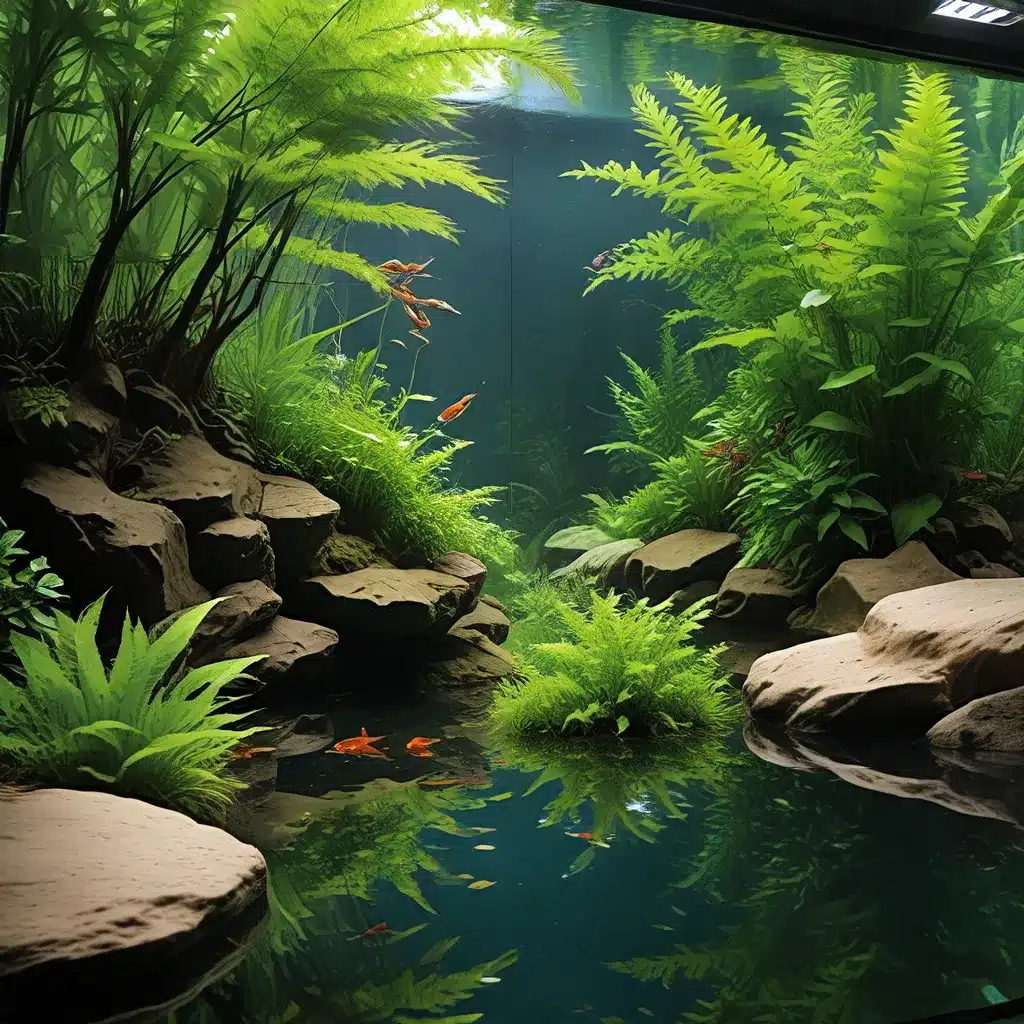
Aquascaping, the art of designing and arranging aquarium elements, is a captivating pursuit that transforms ordinary fish tanks into living works of art. At the heart of this discipline lies the harmonious integration of natural aquatic plants, which can elevate an aquarium’s aesthetic appeal and provide a thriving habitat for its inhabitants.
Achieving Balance and Perspective in Aquascaping
Successful aquascaping hinges on striking a delicate balance between the various elements within the aquarium. Whether you’re aiming for a lush, nature-inspiredscape or a vibrant, densely-planted display, the principles of balance, perspective, and harmony are paramount. By carefully selecting and arranging aquatic plants, rocks, and driftwood, aquarium enthusiasts can transform their underwater environments into captivating reflections of the natural world.
One of the key aspects of aquascaping is the creation of focal points. These eye-catching elements, such as a striking rock formation or a unique piece of driftwood, draw the viewer’s attention and add depth to the overall composition. Balancing these focal points with the surrounding plants and hardscape ensures a cohesive and visually engaging aquascape.
Aquascaping Styles: From Nature to Dutch
The world of aquascaping encompasses a diverse range of styles, each with its own unique characteristics and design principles. The Nature Aquarium style, for instance, emphasizes the replication of natural aquatic environments, such as riverbanks and rocky shores. By incorporating a variety of aquatic plants, driftwood, and strategically placed rocks, aquarists can create a serene and authentic underwater landscape that evokes a sense of tranquility.
In contrast, the Dutch Style aquascape is characterized by its dense and orderly arrangement of aquatic plants. This approach focuses on creating vibrant, colorful displays through the selection of plants with contrasting leaf shapes, sizes, and hues. The plants are typically arranged in strict horizontal and vertical lines, creating a sense of structure and depth within the aquarium.
Aquatic Plant Selection and Placement
The selection and placement of aquatic plants are crucial elements in crafting a harmonious aquascape. When choosing plants, it’s essential to consider their growth patterns, lighting requirements, and compatibility with the intended aquarium inhabitants. Incorporating a variety of plant types, including foreground, midground, and background species, can contribute to the overall depth and visual appeal of the aquascape.
Low-maintenance plants, such as Java Fern and Anubias, are often recommended for beginners, as they thrive under a wide range of lighting and nutrient conditions. More demanding species, like carpeting plants, may require higher light intensity and nutrient supplementation to flourish in the aquarium environment.
Hardscape Elements: Rocks, Driftwood, and Substrate
The hardscape, including rocks, driftwood, and substrate, forms the foundation of a well-executed aquascape. These elements not only contribute to the overall aesthetic but also provide essential functions, such as anchoring plants, creating visual interest, and enhancing water circulation.
When selecting hardscape materials, it’s crucial to choose items that complement the chosen aquascaping style and plant selection. Rocks, such as lava rock or seiryu stone, can add texture and character to the aquarium, while driftwood can lend an authentic, natural touch. The substrate, which can range from nutrient-rich soil to gravel, plays a vital role in supporting healthy plant growth and providing a stable foundation for the aquascape.
Lighting, CO2, and Nutrient Management
Maintaining the optimal aquarium environment is essential for the long-term health and vibrancy of the aquascape. Proper lighting, CO2 supplementation, and nutrient management are all crucial factors in ensuring the success of a planted tank.
Aquarium plants have varying light requirements, ranging from low to high intensity. Selecting lighting fixtures that provide the appropriate spectrum and intensity for your chosen plant species can significantly enhance their growth and appearance. In high-tech aquariums, adjustable LED or fluorescent lights offer versatility in controlling light levels and promoting lush plant development.
In addition to lighting, CO2 supplementation can be a game-changer for aquatic plant growth. By injecting the right amount of carbon dioxide into the water, aquarists can support the photosynthesis process and encourage robust, vibrant plant health. Careful monitoring and adjustments to the CO2 system are essential to maintain a balanced ecosystem.
Nutrient management, including the use of fertilizers and substrate additives, plays a crucial role in sustaining a thriving aquascape. Providing the necessary macronutrients (nitrogen, phosphorus, and potassium) and micronutrients can help prevent deficiencies and ensure the overall well-being of the aquarium plants.
Maintenance and Preservation of the Aquascape
Maintaining a healthy and visually appealing aquascape requires consistent attention and care. Regular tasks such as pruning, trimming, and water changes are essential to preserve the integrity of the layout and prevent overgrowth or imbalances in the ecosystem.
Pruning aquatic plants, both for aesthetic and health reasons, helps maintain the desired shape and composition of the aquascape. Removing dead or dying leaves, as well as judiciously trimming overgrown areas, can promote new growth and maintain the overall harmony of the underwater landscape.
Conducting routine water changes and monitoring water parameters, such as pH, ammonia, nitrite, and nitrate levels, is crucial for sustaining a thriving aquarium environment. These actions help remove accumulated toxins, replenish essential minerals, and support the overall health of the aquatic plants and inhabitants.
Embracing the Art of Aquascaping
Aquascaping is a captivating blend of art, science, and passion. By understanding the principles of balance, perspective, and harmony, aquarium enthusiasts can craft breathtaking underwater landscapes that mimic the natural world. Whether you’re drawn to the serene beauty of the Nature Aquarium style or the vibrant, structured appeal of the Dutch Style, the art of aquascaping offers endless opportunities for creative expression and the creation of truly unique aquatic environments.
As you embark on your aquascaping journey, remember to embrace the process, experiment with different techniques, and adapt your approach as your aquarium plants grow and evolve. With dedication, attention to detail, and a touch of creativity, your aquarium can become a mesmerizing centerpiece, not just for your home or office, but for the entire aquatic community to admire and appreciate.
Happy aquascaping, and may your underwater landscapes flourish with the harmony of nature!

